Featured Image; Virgin Galactic
Lift Off Time/Launch Window | May 25, 2023 – 13:00 UTC | 06:00 MST |
|---|---|
Mission Name | VSS Unity 25 |
Launch Provider | Virgin Galactic |
Customer | Virgin Galactic |
Rocket | SpaceShipTwo |
Launch Location | VMS Eve, Spaceport America, New Mexico, USA |
Payload mass | N/A |
Where is the spacecraft going? | Suborbital |
Will they be attempting to recover the first stage? | Yes |
Where will the first stage land? | SpaceShipTwo will land on a runway at Spaceport America, New Mexico, USA |
Will they be attempting to recover the fairings? | There are no fairings on SpaceShipTwo |
Are these fairings new? | There are no fairings on SpaceShipTwo |
How’s the weather looking? | TBD |
This will be the: | – 2nd fully crewed flight of SpaceShipTwo – 25th flight of VSS Unity – 14th mission for SpaceShipTwo – 2nd mission for SpaceShipTwo in 2023 – 5th crewed flight of VSS Unity |
Where to watch | There will not be a live stream |
What’s All This Mean?
In what will hopefully be the last test flight before commercial operations can begin, VSS Unity 25 will test the “astronaut experiance” among other last step items. VSS Unity is operated by Virgin Galactic, a company that is part of Richard Branson’s Virgin Group. Virgin Galatic’s main purpose is space tourism, so once these test flights are complete, the company can start selling tickets to those willing to pay.
The launch will take place from Spaceport America in New Mexico and will follow a suborbital trajectory. A total of six people will be onboard which includes two pilots and four mission specialists. Following the launch, the spacecraft will coast back to Earth and land on a runway like an ordinary airplane.
Who Is On Unity 25?
VSS Unity has the ability to carry up to six people, two of which are trained and experienced pilots, while the others are passengers. For Unity 25, CJ Sturckow and Michael Masucci will serve as the mission pilots of VSS Unity. The mothership, VMS Eve, will be piloted by Jamile Janjua and Nicola Pecile. Accompanying the pilots of VSS Unity are Beth Moses, Luke Mays, Jamila Gilbert, and Christopher Huie, whom all hold great importance to the company’s success.
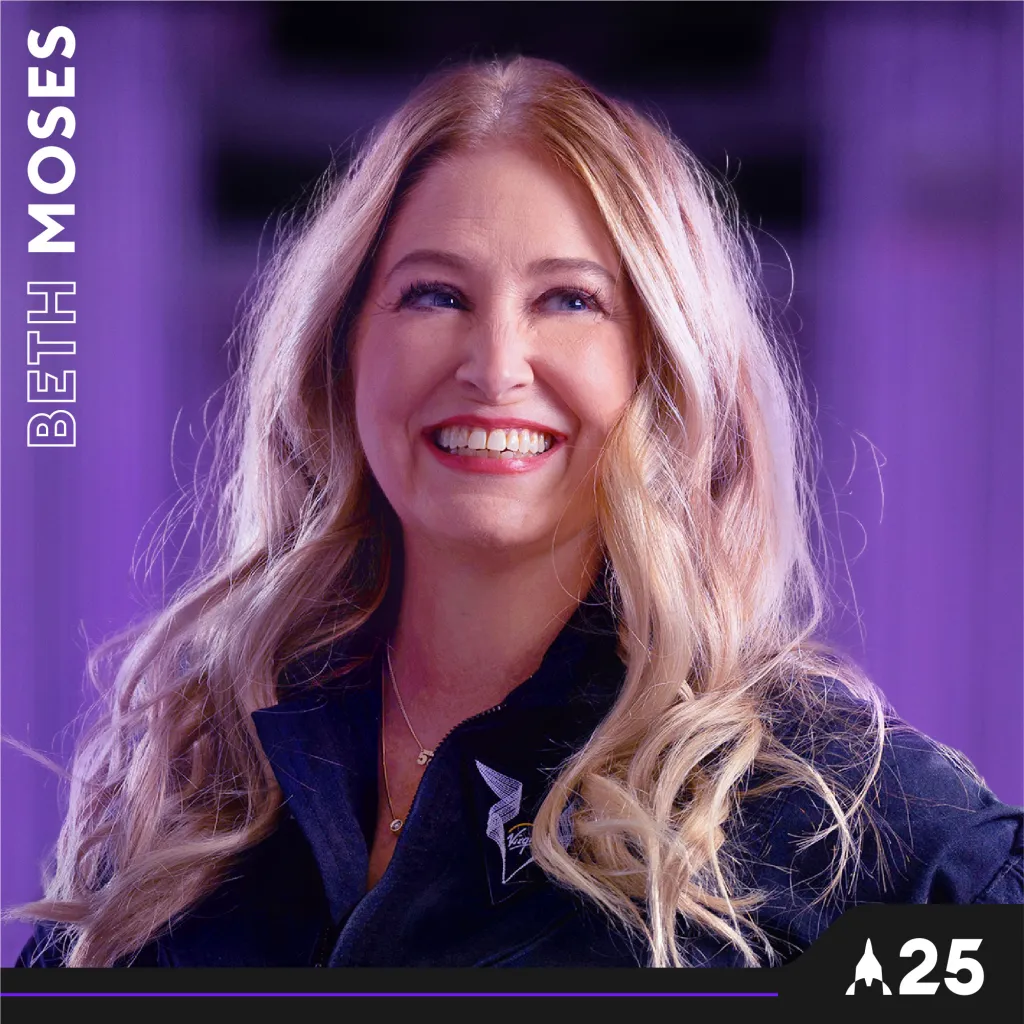
Beth Moses
As the Chief Astronaut Instructor at Virgin Galactic, Beth Moses holds critical importance to the Virgin Galactic team and their ventures into inviting the general public onto their flights. She graduated from Purdue University with bachelors and masters degrees in aeronautical and astronautical engineering.
Moses has flown once before for Virgin Galactic in February of 2019; she become the first person to release their harness and float about the cabin, on a suborbital flight.
This will be her third spaceflight.
Luke Mays
Having only just joined Virgin Galactic in March, Luke Mays is already well underway at his new employer. Mays has previously done work at NASA training astronauts and developing reliable training schedules.
Sometimes, the best way to teach is to experience something for oneself. As an astronaut instructor, it only makes Mays more knowledgeable to experience what future ticket buyers will do through on their first flights.
This will be his first spaceflight.


Jamila Gilbert
Having been at Virgin Galactic since 2019, Jamila Gilbert has filled a lead internal communications role. She studied a wide variety of subjects at New Mexico State University including; linguistics, museum conservation, anthropology, and studio art. Gilbert has Purépechan-Mexican roots and can speak four different languages.
Resembling many of Virgin Galactic’s anticipated customers, Gilbert does not have an engineering background. Therefore, she will be able to provide a unique perspective on the experience.
This will be her first spaceflight.
Christopher Huie
Christopher “Chuie” Huie has been with Virgin Galactic for six years as an aerospace engineer. He obtained is degree from the University of Maryland Clark School of Engineering and has extensive knowledge of VMS Eve, aka “WhiteKnightTwo”, and VSS Unity.
He also holds a leadership position at Virgin Galactic as the Senior Manager of the Flight Sciences Engineering team. Additionally, he is the leader of the Black Leadership in Aerospace Scholarship and Training (BLAST) program encouraging more black leadership in the aerospace industry.
This will be his first flight. He will become the 19th black astronaut in the world.

What Is SpaceShipTwo?
SpaceShipTwo is a rocket powered spaceplane that launches from under the wing of a carrier aircraft. It uses a hybrid rocket engine to boost itself up to beyond the edge of space to give paying passengers a few minutes of weightlessness.
VSS Unity is the second SpaceShipTwo vehicle. The previous vehicle, VSS Enterprise, crashed in 2014 in an accident which killed the co-pilot Michael Alsbury. The pilot, Peter Siebold, also suffered severe injuries in the accident. That flight was from Mojave Air and Space Port, California, before Virgin Galactic moved its operations to New Mexico. An investigation found that the crash occurred when the tail section accidentally moved into the feathered position during powered ascent.
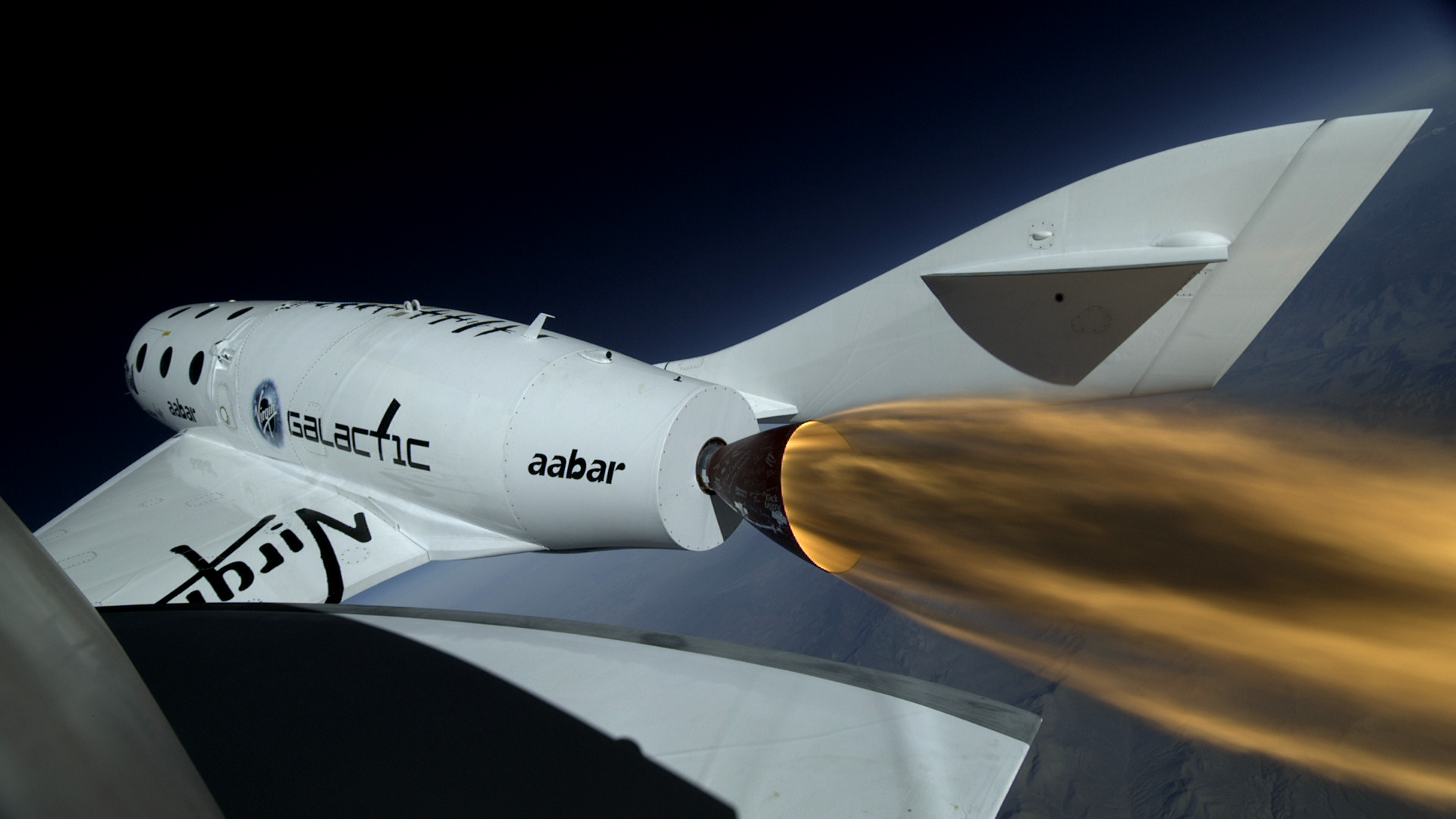
SpaceShipTwo and its mothercraft, White Knight Two, were designed and built by The Spaceship Company, formed by Burt Rutan and Sir Richard Branson in 2005. Burt Rutan’s pre-existing company, Scaled Composites, previously built and flew SpaceShipOne.
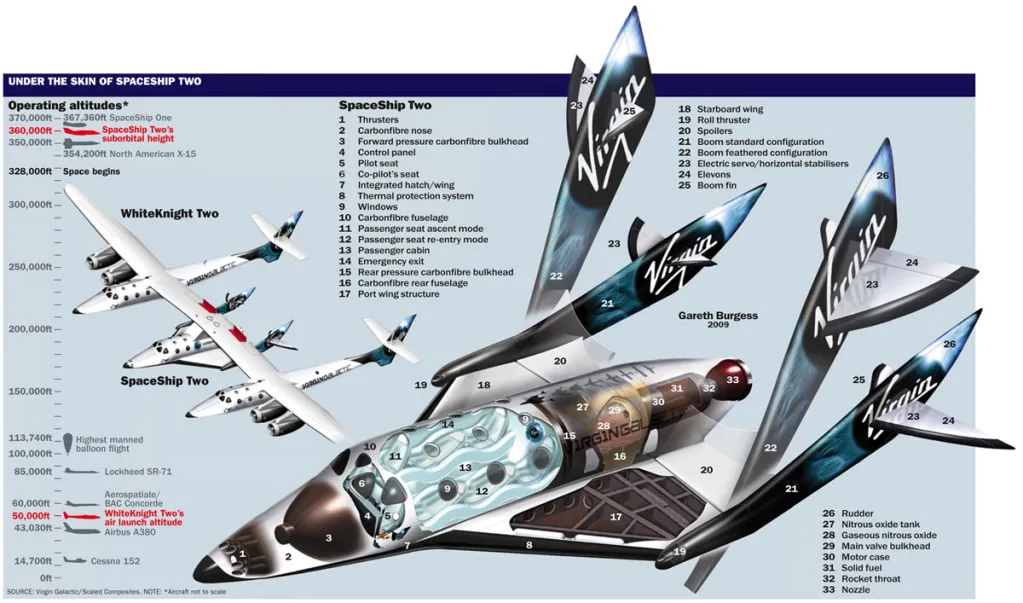
SpaceShipTwo is designed to fly with two flight crew and four passengers. It uses its onboard rocket motor for powered ascent following separation from White Knight Two. On reaching apogee, it deploys a special feathered tail section in order to gain the proper nose-down attitude prior to reentry.
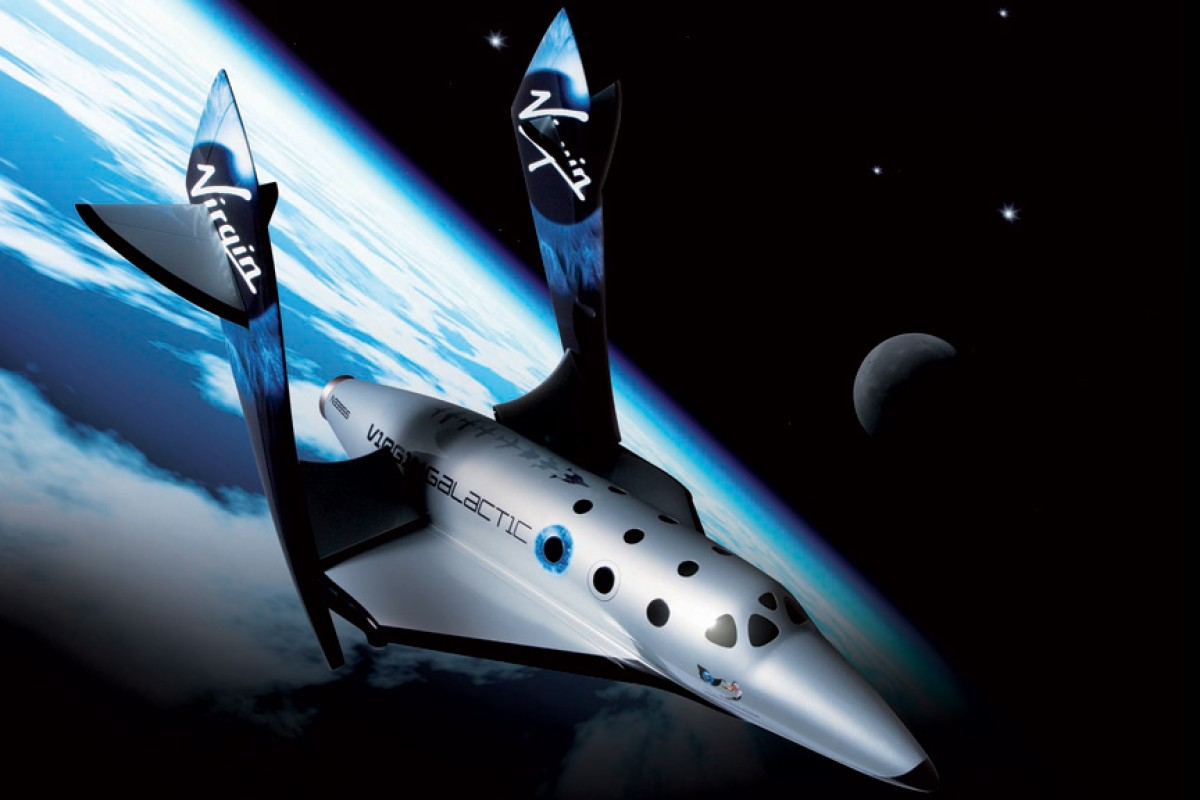
SpaceShipTwo’s Rocket Motor
SpaceShipTwo originally used a hybrid motor developed by Sierra Nevada Corporation. This engine used hydroxyl-terminated polybutadiene (HTPB) as fuel and nitrous oxide (N20) as oxidizer. A hybrid engine is one in which the fuel and oxidizer exist in different phases of matter. In this case, the fuel is solid, and the oxidizer is stored as liquid and consumed as a gas.
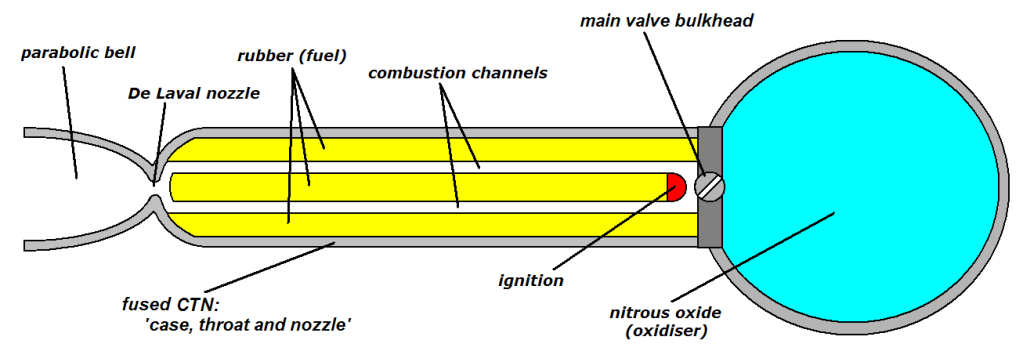
Around the time of the crash of VSS Enterprise, Virgin Galactic experimented with changing the engine design to run on a polyamide plastic fuel instead of HTPB. Since then, however, Virgin has switched back to using HTPB again, but now produces the current RocketMotorTwo engines in house instead of buying them from SNC.
What Is White Knight Two?
White Knight Two is the carrier aircraft that takes SpaceShipTwo up from local ground level to an altitude above mean sea level of 15,000 m (50,000 ft). The carrier aircraft then releases SpaceShipTwo which begins its own powered flight seconds later.
White Knight Two then returns to land under normal jet engine power, as during its ascent. The aircraft has four Pratt & Whitney PW308 engines and two fuselages. Each engine provides 30.7 kN (6,900 lbf) of thrust. One fuselage holds the active cockpit for control of the aircraft, while the other fuselage is a direct copy of SpaceShipTwo. This is so that White Knight Two can be used for training crew and passengers on what to expect for their flights on board SpaceShipTwo.

The first White Knight Two vehicle, VMS Eve, flew for the first time in 2008. It has a flight crew of two people, plus additional people to take part in the deployment of the spacecraft, and those undergoing training for SpaceShipTwo.
White Knight Two has a service ceiling of 21,000 m (70,000 ft), based on a relatively large wingspan of 43 m (141 ft).






Fantastic overview!
Nice to see the progress. I worked at Scaled Composites and help to build White Knight 2. I was hired on shortly after 3 people were killed in an accident testing the rocket engines. May all the rest that fly with it make it back safely